The Effectiveness of Molecular, Karyotype and Morphological Methods in the Identification of Morphologically Conservative Sibling Species: An Integrative Taxonomic Case of the Crocidura attenuata Species Complex in Mainland China
Abstract
Simple Summary
Abstract
1. Introduction
2. Materials and Methods
2.1. Molecular Analysis
2.2. Karyotype Analysis
2.3. Morphological Analysis
3. Results
3.1. Sequence, Phylogeny and Genetic Distances
3.2. Karyotype and Karyogram
3.3. Metrological Morphology and Morphological Characteristics
4. Discussion
4.1. Species Classification and Distribution Revision of the C. attenuata Species Complex
4.2. The Confusion in the Taxonomy of the Crocidura attenuata Species Complex
4.3. The Taxonomic Effectiveness of Molecular, Karyotype and Morphological Methods
5. Conclusions
Supplementary Materials
Author Contributions
Funding
Institutional Review Board Statement
Informed Consent Statement
Data Availability Statement
Acknowledgments
Conflicts of Interest
References
- Wan, T.; He, K.; Jiang, X.L. Multilocus Phylogeny and Cryptic Diversity in Asian Shrew-like Moles (Uropsilus, Talpidae): Implications for Taxonomy and Conservation. BMC Evol. Biol. 2013, 13, 232. [Google Scholar] [CrossRef] [PubMed]
- He, K.; Shinohara, A.; Helgen, K.M.; Springer, M.S.; Jiang, X.-L.; Campbell, K.L. Talpid Mole Phylogeny Unites Shrew Moles and Illuminates Overlooked Cryptic Species Diversity. Mol. Biol. Evol. 2017, 34, 78–87. [Google Scholar] [CrossRef]
- Koju, N.P.; He, K.; Chalise, M.K.; Ray, C.; Chen, Z.; Zhang, B.; Wan, T.; Chen, S.; Jiang, X. Multilocus Approaches Reveal Underestimated Species Diversity and Inter-Specific Gene Flow in Pikas (Ochotona) from Southwestern China. Mol. Phylogenet. Evol. 2017, 107, 239–245. [Google Scholar] [CrossRef]
- Li, H.; Kong, L.; Wang, K.; Zhang, S.; Motokawa, M.; Wu, Y.; Wang, W.; Li, Y. Molecular Phylogeographic Analyses and Species Delimitations Reveal That Leopoldamys Edwardsi (Rodentia: Muridae) Is a Species Complex. Integr. Zool. 2019, 14, 494–505. [Google Scholar] [CrossRef]
- Bugarski-Stanojević, V.; Stamenković, G.; Jojić, V.; Ćosić, N.; Ćirović, D.; Stojković, O.; Veličković, J.; Savić, I. Cryptic Diversity of the European Blind Mole Rat Nannospalax Leucodon Species Complex: Implications for Conservation. Animals 2022, 12, 1097. [Google Scholar] [CrossRef]
- Yu, W.; Lin, C.; Huang, Z.; Liu, S.; Wang, Q.; Quan, R.; Li, S.; Wu, Y. Discovery of Kerivoula Kachinensis and a Validity of K. Titania (Chiroptera: Vespertilionidae) in China. Mammalia 2022, 86, 303–308. [Google Scholar] [CrossRef]
- Huang, C.; Yu, W.; Xu, Z.; Qiu, Y.; Chen, M.; Qiu, B.; Motokawa, M.; Harada, M.; Li, Y.; Wu, Y. A Cryptic Species of the Tylonycteris Pachypus Complex (Chiroptera: Vespertilionidae) and Its Population Genetic Structure in Southern China and Nearby Regions. Int. J. Biol. Sci. 2014, 10, 200–211. [Google Scholar] [CrossRef]
- Li, Y.; Li, Y.; Li, H.; Wang, J.; Rong, X.; Li, Y. Niviventer Confucianus Sacer (Rodentia, Muridae) Is a Distinct Species Based on Molecular, Karyotyping, and Morphological Evidence. Zookeys 2020, 959, 137–159. [Google Scholar] [CrossRef]
- Lim, K.C.; White, W.T.; Then, A.Y.H.; Naylor, G.J.P.; Arunrugstichai, S.; Loh, K.-H. Integrated Taxonomy Revealed Genetic Differences in Morphologically Similar and Non-Sympatric Scoliodon Macrorhynchos and S. Laticaudus. Animals 2022, 12, 681. [Google Scholar] [CrossRef]
- Liu, S.; Zhou, C.; Meng, G.; Wan, T.; Tang, M.; Yang, C.; Murphy, R.W.; Fan, Z.; Liu, Y.; Zeng, T.; et al. Evolution and Diversification of Mountain Voles (Rodentia: Cricetidae). Commun. Biol. 2022, 5, 1417. [Google Scholar] [CrossRef] [PubMed]
- Burgin, C.J.; He, K. Family Soricidae (shrew). In Hand Book of the Mammals of the World: Insectivores, Sloths and Colugos; Wilson, D.E., Russell, A.M., Eds.; Barcelona: Lynx Edicions, Spain, 2018; pp. 474–530. [Google Scholar]
- Jiang, X.; Hoffmann, R.S. A revision of the white-toothed shrews (Crocidura) of Southern China. J. Mammal. 2001, 82, 1059–1079. [Google Scholar] [CrossRef]
- Stanley, W.T.; Hutterer, R.; Giarla, T.C.; Esselstyn, J.A. Phylogeny, Phylogeography and Geographical Variation in the Crocidura Monax (Soricidae) Species Complex from the Montane Islands of Tanzania, with Descriptions of Three New Species. Zool. J. Linn. Soc. 2015, 174, 185–215. [Google Scholar] [CrossRef]
- Nicolas, V.; Jacquet, F.; Hutterer, R.; Konečný, A.; Kouassi, S.K.; Durnez, L.; Lalis, A.; Colyn, M.; Denys, C. Multilocus Phylogeny of the Crocidura Poensis Species Complex (Mammalia, Eulipotyphla): Influences of the Palaeoclimate on Its Diversification and Evolution. J. Biogeogr. 2019, 46, 871–883. [Google Scholar] [CrossRef]
- Wei, F.; Yang, Q.; Wu, Y.; Jiang, X.; Liu, S.; Li, B.; Yang, G.; Li, M.; Zhou, J.; Li, S.; et al. Catalogue of mammals in China (2021). Acta Theriol. Sin. 2021, 41, 487–501. [Google Scholar]
- Chen, S.; Qing, J.; Liu, Z.; Liu, Y.; Tang, M.; Murphy, R.W.; Pu, Y.; Wang, X.; Tang, K.; Guo, K.; et al. Multilocus Phylogeny and Cryptic Diversity of White-Toothed Shrews (Mammalia, Eulipotyphla, Crocidura) in China. BMC Evol. Biol. 2020, 20, 29. [Google Scholar] [CrossRef] [PubMed]
- Hutterer, R. Order Soricomorpha. In Mammal Species of the World a Taxonomic and Geographic Reference, 3rd ed.; Wilson, D.E., Reeder, D.M., Eds.; The Johns Hopkins University Press: Baltimore, MD, USA, 2005. [Google Scholar]
- Ellerman, J.; Morrison-Scott, T. Checklist of Palaearctic and Indian Mammals, 1758 to 1946; British Museum, Natural History: London, UK, 1951. [Google Scholar]
- Jameson, E.; Jones, G. The Soricidae of Taiwan. Proc. Biol. Soc. Wash. 1977, 90, 459–482. [Google Scholar]
- Corbet, G.B.; Hill, J.E. The Mammals of the Indomalayan Region: A Systematic Review; Natural History Museum publications; Oxford University Press: Oxford, UK, 1992. [Google Scholar]
- Hutterer, R. Order Insectivora. In Mammal Species of the World: A Taxonomic and Geographic Reference, 2nd ed.; Wilson, D.E., Reeder, D.M., Eds.; Smithsonian Institution Press: Washington, DC, USA, 1993; pp. 69–130. [Google Scholar]
- Fang, Y.; Lee, L.; Yew, F.; Yu, H. Systematics of White-toothed Shrews (Crocidura) (Mammalia: Insectivora: Soricidae) of Taiwan: Karyological and Morphological Studies. J. Zool. 1997, 242, 151–166. [Google Scholar] [CrossRef]
- Motokawa, M.; Harada, M.; Lin, L.K.; Koyasu, K.; Hattori, S. Karyological Study of the Gray Shrew Crocidura attenuata (Mammalia: Insectivora) from Taiwan. Zool. Stud. 1997, 36, 70–73. [Google Scholar]
- Motokawa, M.; Harada, M.; Wu, Y.; Lin, L.-K.; Suzuki, H. Chromosomal Polymorphism in the Gray Shrew Crocidura Attenuata (Mammalia: Insectivora). Zool. Sci. 2001, 18, 1153–1160. [Google Scholar] [CrossRef]
- Ohdachi, S.D.; Hasegawa, M.; Iwasa, M.A.; Vogel, P.; Oshida, T.; Lin, L.K.; Abe, H. Molecular Phylogenetics of Soricid Shrews (Mammalia) Based on Mitochondrial Cytochrome b Gene Sequences: With Special Reference to the Soricinae. J. Zool. 2006, 270, 177–191. [Google Scholar] [CrossRef]
- Esselstyn, J.A.; Timm, R.M.; Brown, R.M. Do Geological or Climatic Processes Drive Speciation in Dynamic Archipelagos? The Tempo and Mode of Diversification in Southeast Asian Shrews. Evolution 2009, 63, 2595–2610. [Google Scholar] [CrossRef]
- Esselstyn, J.A.; Oliveros, C.H. Colonization of the Philippines from Taiwan: A Multi-Locus Test of the Biogeographic and Phylogenetic Relationships of Isolated Populations of Shrews. J. Biogeogr. 2010, 37, 1504–1514. [Google Scholar] [CrossRef]
- Bannikova, A.A.; Abramov, A.V.; Borisenko, A.V.; Lebedev, V.S.; Rozhnov, V.V. Mitochondrial Diversity of the White-Toothed Shrews (Mammalia, Eulipotyphla, Crocidura) in Vietnam. Zootaxa 2011, 2812, 1–20. [Google Scholar] [CrossRef]
- Abramov, A.V.; Bannikova, A.A.; Rozhnov, V.V. White-Toothed Shrews (Mammalia, Soricomorpha, Crocidura) of Coastal Islands of Vietnam. Zookeys 2012, 207, 37–47. [Google Scholar] [CrossRef] [PubMed]
- Li, Y.; Li, H.; Motokawa, M.; Wu, Y.; Harada, M.; Sun, H.; Mo, X.; Wang, J.; Li, Y. A Revision of the Geographical Distributions of the Shrews Crocidura tanakae and C. attenuata Based on Genetic Species Identification in the Mainland of China. Zookeys 2019, 869, 147–160. [Google Scholar] [CrossRef] [PubMed]
- Zhang, H.; Wu, G.Y.; Wu, Y.Q.; Yao, J.F.; You, S.; Wang, C.C.; Cheng, F.; Chen, J.J.; Tang, M.X.; Li, C.L.; et al. A new species of the genus Crocidura from China based on molecular and morphological data (Eulipotyphla: Soricidae). Zool. Syst. 2019, 4, 279–293. [Google Scholar]
- Liu, Y.; Chen, S.; Liu, B.; Liao, R.; Liu, Y.; Liu, S. A New Species of the Genus Crocidura (Eulipotyphla: Soricidae) from Zhejiang Pvovince, Eastern China. Acta Theriol. Sin. 2020, 40, 1–12. [Google Scholar]
- Sikes, R.S. Animal Care and Use Committee of the American Society of Mammalogists 2016 Guidelines of the American Society of Mammalogists for the Use of Wild Mammals in Research and Education. J. Mammal. 2016, 97, 663–688. [Google Scholar] [CrossRef]
- Li, H.; Mo, X.; Sun, H.; Wang, J.; Motokawa, M.; Harada, M.; Wu, Y.; Li, Y. Karyotypic Polymorphism of Crocidura tanakae (Eulipotyphla: Soricidae) and Revision of the Karyotype of C. attenuata in Mainland China. J. Mammal. 2020, 101, 1548–1560. [Google Scholar] [CrossRef]
- Hall, T.A. BioEdit: A user-friendly biological sequence alignment editor and analysis program for Windows 95/98/NT. Nucleic Acids Symp. Ser. 1999, 41, 95–98. [Google Scholar]
- Kumar, S.; Stecher, G.; Li, M.; Knyaz, C.; Tamura, K. MEGA X: Molecular Evolutionary Genetics Analysis across computing platforms. Mol. Biol. Evol. 2018, 35, 1547–1549. [Google Scholar] [CrossRef] [PubMed]
- Darriba, D.; Taboada, G.L.; Doallo, R.; Posada, D. jModelTest 2: More models, new heuristics and parallel computing. Nat. Methods 2012, 9, 772. [Google Scholar] [CrossRef]
- Ronquist, F.; Teslenko, M.; van der Mark, P.; Ayres, D.L.; Darling, A.; Höhna, S.; Larget, B.; Liu, L.; Suchard, M.A.; Huelsenbeck, J.P. MrBayes 3.2: Efficient Bayesian Phylogenetic Inference and Model Choice across a Large Model Space. Syst. Biol. 2012, 61, 539–542. [Google Scholar] [CrossRef]
- Patton, J.L. Chromosome Studies of Certain Pocket Mice, Genus Perognathus (Rodentia: Heteromyidae). J. Mammal. 1967, 48, 27–37. [Google Scholar] [CrossRef] [PubMed]
- Harada, M.; Yosida, T.H. Karyological Study of Four Japanese Myotis Bats (Chiroptera, Mammalia). Chromosoma 1978, 65, 283–291. [Google Scholar] [CrossRef]
- Searle, J.B. Factors Responsible for a Karyotypic Polymorphism in the Common Shrew, Sorex araneus. Proc. R. Soc. Lond. B Biol. Sci. 1986, 229, 277–298. [Google Scholar]
- Kitchener, D.J.; Schmitt, L.H. Maharadatunkamsi Morphological and Genetic Variation in Suncus murinus (Soricidae: Crocidurinae) from Java, Lesser Sunda Islands, Maluku and Sulawesi, Indonesia. Mammalia 1994, 58, 433–451. [Google Scholar] [CrossRef]
- Motokawa, M.; Hattori, S.; Ota, H.; Hikida, T. Geographic Variation in the Watase’s Shrew Crocidura watasei (Insectivora, Soricidae) from the Ryukyu Archipelago, Japan. Mammalia 1996, 60, 243–254. [Google Scholar] [CrossRef]
- Motokawa, M. Geographic Variation in the Japanese White-Toothed Shrew Crocidura dsinezumi. Acta Theriol. 2003, 48, 145–156. [Google Scholar] [CrossRef]
- Hutterer, R.; Balete, D.S.; Giarla, T.C.; Heaney, L.R.; Esselstyn, J.A. A New Genus and Species of Shrew (Mammalia: Soricidae) from Palawan Island, Philippines. J. Mammal. 2018, 99, 518–536. [Google Scholar] [CrossRef]
- Meegaskumbura, S.; Meegaskumbura, M.; Pethiyagoda, R.; Manamendra-Arachchi, K.; Schneider, C.J. Crocidura hikmiya, a New Shrew (Mammalia: Soricomorpha: Soricidae) from Sri Lanka. Zootaxa 2007, 1665, 19–30. [Google Scholar]
- Bradley, R.D.; Baker, R.J. A test of the Genetic Species Concept: Cytochrome-b sequences and mammals. J. Mammal. 2001, 82, 960–973. [Google Scholar] [CrossRef]
- Baker, R.J.; Bradley, R.D. Speciation in mammals and the genetic species concept. J. Mammal. 2006, 87, 643–662. [Google Scholar] [CrossRef] [PubMed]
- Liu, Y.; Zhang, H.; Zhang, C.L.; Wu, J.; Wang, Z.C.; Li, C.L.; Zhang, B.W. A new species of the genus Crocidura (Mammalia: Eulipotyphla: Soricidae) from Mount Huang, China. Zool. Syst. 2020, 45, 1–14. [Google Scholar]
- Jenkins, P.D.; Lunde, D.P.; Moncrieff, C.B. Chapter 10. Descriptions of New Species of Crocidura (Soricomorpha: Soricidae) from Mainland Southeast Asia, with Synopses of Previously Described Species and Remarks on Biogeography. Bull. Am. Mus. Nat. Hist. 2009, 331, 356–405. [Google Scholar] [CrossRef]
- Jenkins, P.D.; Abramov, A.V.; Bannikova, A.A.; Rozhnov, V.V. Bones and Genes: Resolution Problems in Three Vietnamese Species of Crocidura (Mammalia, Soricomorpha, Soricidae) and the Description of an Additional New Species. Zookeys 2013, 313, 61–79. [Google Scholar] [CrossRef] [PubMed]
- Russo, D.; Ancillotto, L.; Hughes, A.C.; Galimberti, A.; Mori, E. Collection of Voucher Specimens for Bat Research: Conservation, Ethical Implications, Reduction, and Alternatives. Mammal. Review. 2017, 47, 237–246. [Google Scholar] [CrossRef]
- Li, Y.; Wu, Y.; Harada, M.; Lin, L.-K.; Motokawa, M. Karyotypes of Three Rat Species (Mammalia: Rodentia: Muridae) from Hainan Island, China, and the Valid Specific Status of Niviventer Lotipes. Zoolog Sci. 2008, 25, 686–692. [Google Scholar] [CrossRef] [PubMed]
- Zima, J. Chromosomal Evolution in Small Mammals (Insectivora, Chiroptera, Rodentia). Hystrix Ital. J. Mammal. 2000, 11, 5–15. [Google Scholar]
- Adams, D.C.; Berns, C.M.; Kozak, K.H.; Wiens, J.J. Are Rates of Species Diversification Correlated with Rates of Morphological Evolution? Proc. Biol. Sci. 2009, 276, 2729–2738. [Google Scholar] [CrossRef] [PubMed]
- Chen, Z.Z.; Tang, H.Y.; Tang, X.F.; Liu, M.W.; Man, X.M.; Zhao, H.T.; Wu, X.B.; Wu, H.L. Discovery of Crocidura tanakae (Mammalia: Soricidae) in Huangshan and Xuancheng, Anhui Province. Chin. J. Zool. 2019, 54, 815–819. [Google Scholar]
- Lei, B.; Yue, Y.; Cui, J.; Ji, S.; Yu, W.; Han, W.; Zhou, Y. A New Record of the Taiwanese Gray Shrew (Crocidura Tanakae Kuroda, 1938) in Hubei Province. Acta Theriol. Sin. 2019, 39, 218–223. [Google Scholar]
- Tu, Y.F. Taiwanese Gray Shrew (Crocidura tanakae) Found in Taohongling National Nature Reserve, Jiangxi. Chin. J. Zool. 2020, 55, 681–682. [Google Scholar]
- Chen, S.; Zhang, Q.; Li, F.; Wang, X.; Wang, Q.; Liu, S. A New Record of Crocidura tanakae kuroda, 1938 in Sichuan and Guizhou Provinces. Acta Theriol. Sin. 2018, 38, 211–216. [Google Scholar]
- Iwasa, M.A.; Ohdachi, S.; Han, S.H.; Oh, H.S.; Abe, H.; Suzuki, H. Karyotype and RFLP of the Nuclear RDNA of Crocidura Sp. on Cheju Island, South Korea (Mammalia, Insectivora). Mammalia 2001, 65, 451–459. [Google Scholar] [CrossRef]
- Zima, J.; Lukácová, L.; Macholán, M. Chromosomal evolution in shrews. In Evolution of Shrews; Wójcik, J.M., Wolsan, M., Eds.; Mammal Research Institute, Polish Academy of Sciences: Bialystok, Poland, 1998; pp. 175–218. [Google Scholar]
- Ruedi, M.; Vogel, P. Chromosomal Evolution and Zoogeographic Origin of Southeast Asian Shrews (Genus Crocidura). Experientia 1995, 51, 174–178. [Google Scholar] [CrossRef]
- Grafodatskiĭ, A.S.; Radzhabli, S.I.; Sharshov, A.V.; Zaĭtsev, M.V. Karyotypes of 5 Species of Soricidae-Crocidura in the Fauna of the USSR. Tsitologiia 1988, 30, 1247–1250. [Google Scholar]
- Maddalena, T.; Ruedi, M. Chromosomal evolution in the genus Crocidura (Insectivora: Soricidae). Adv. Biol. Shrews. Spec. Publ. Carnegie Mus. Nat. Hist. 1994, 18, 335–344. [Google Scholar]
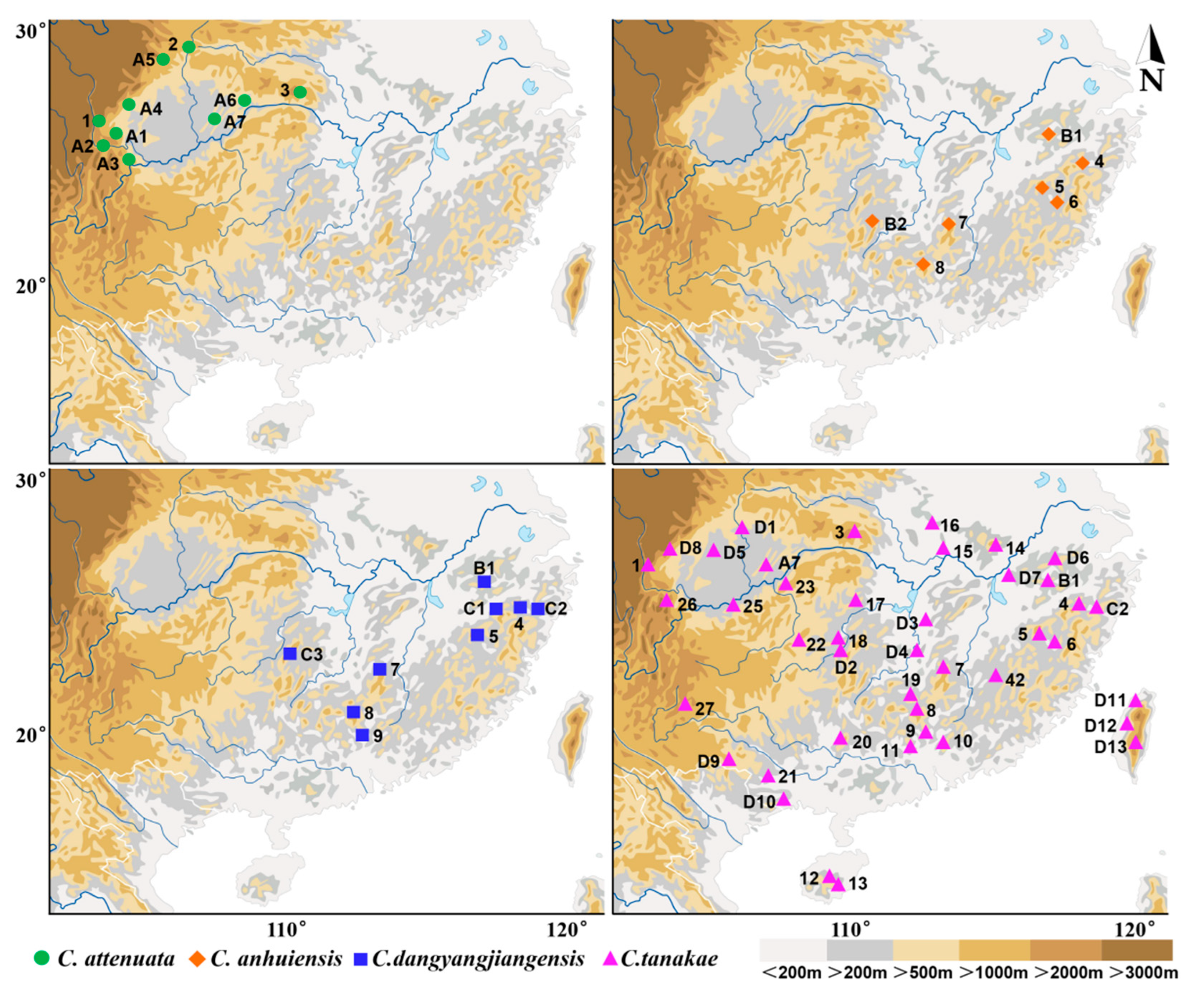
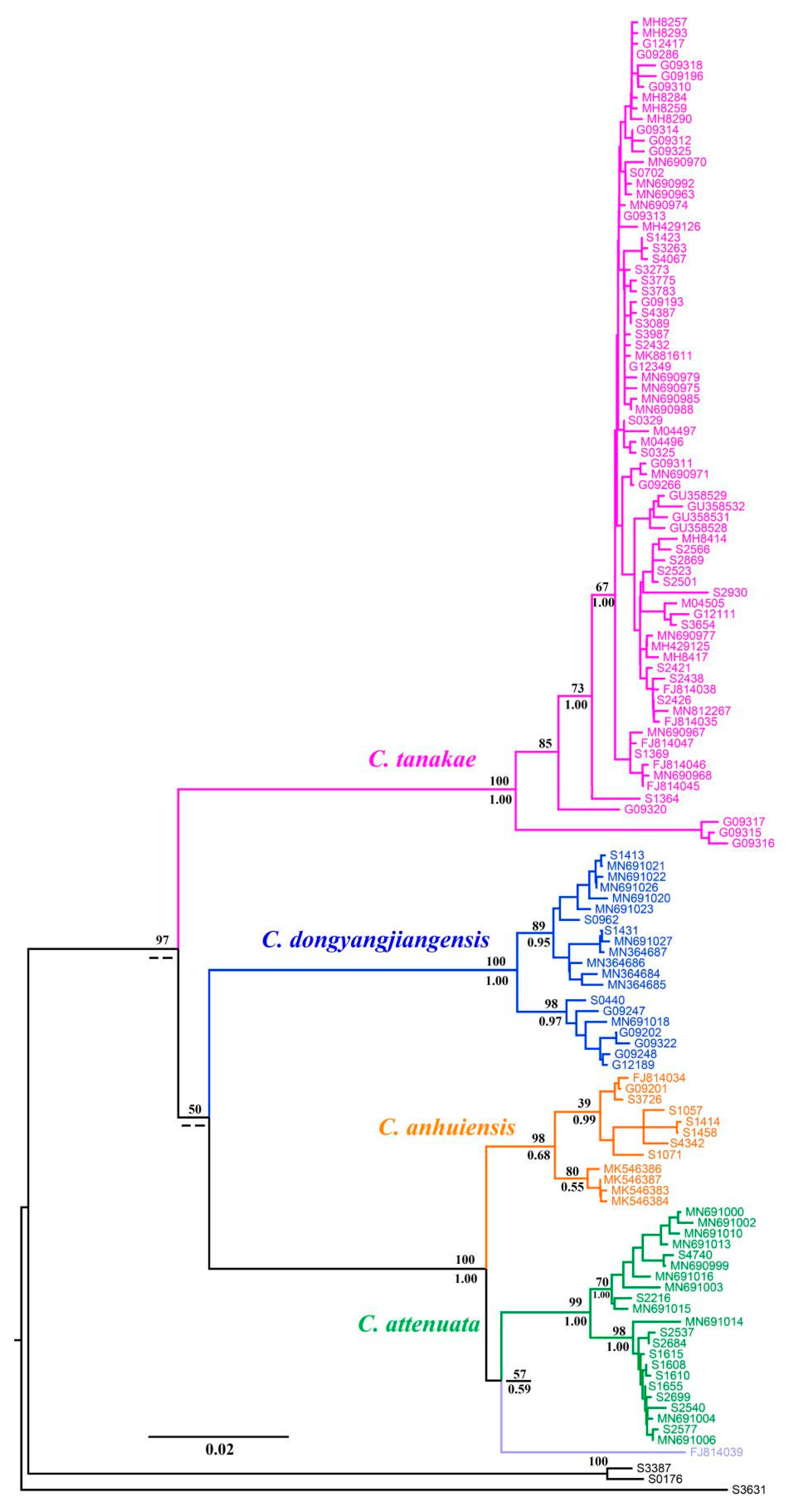
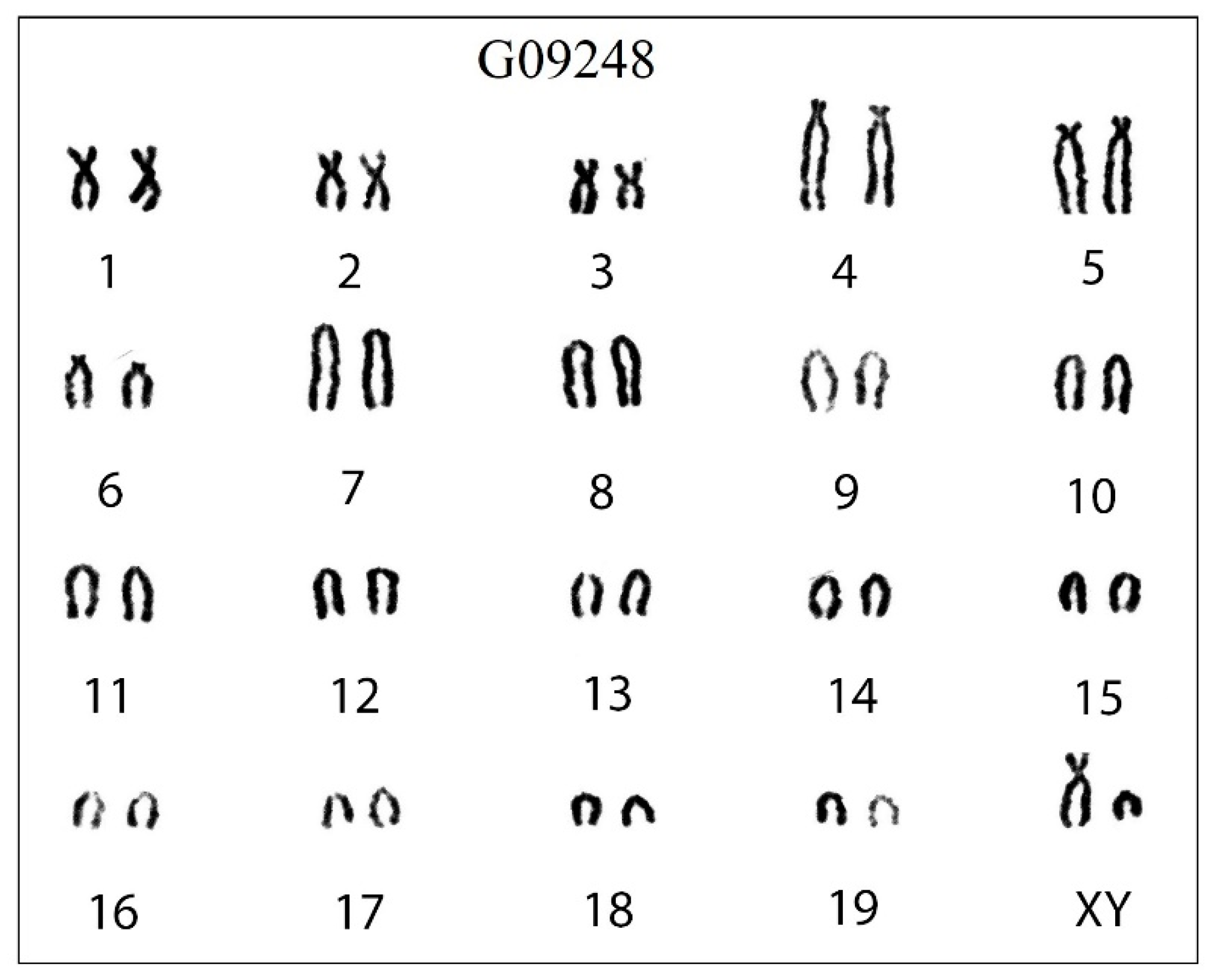
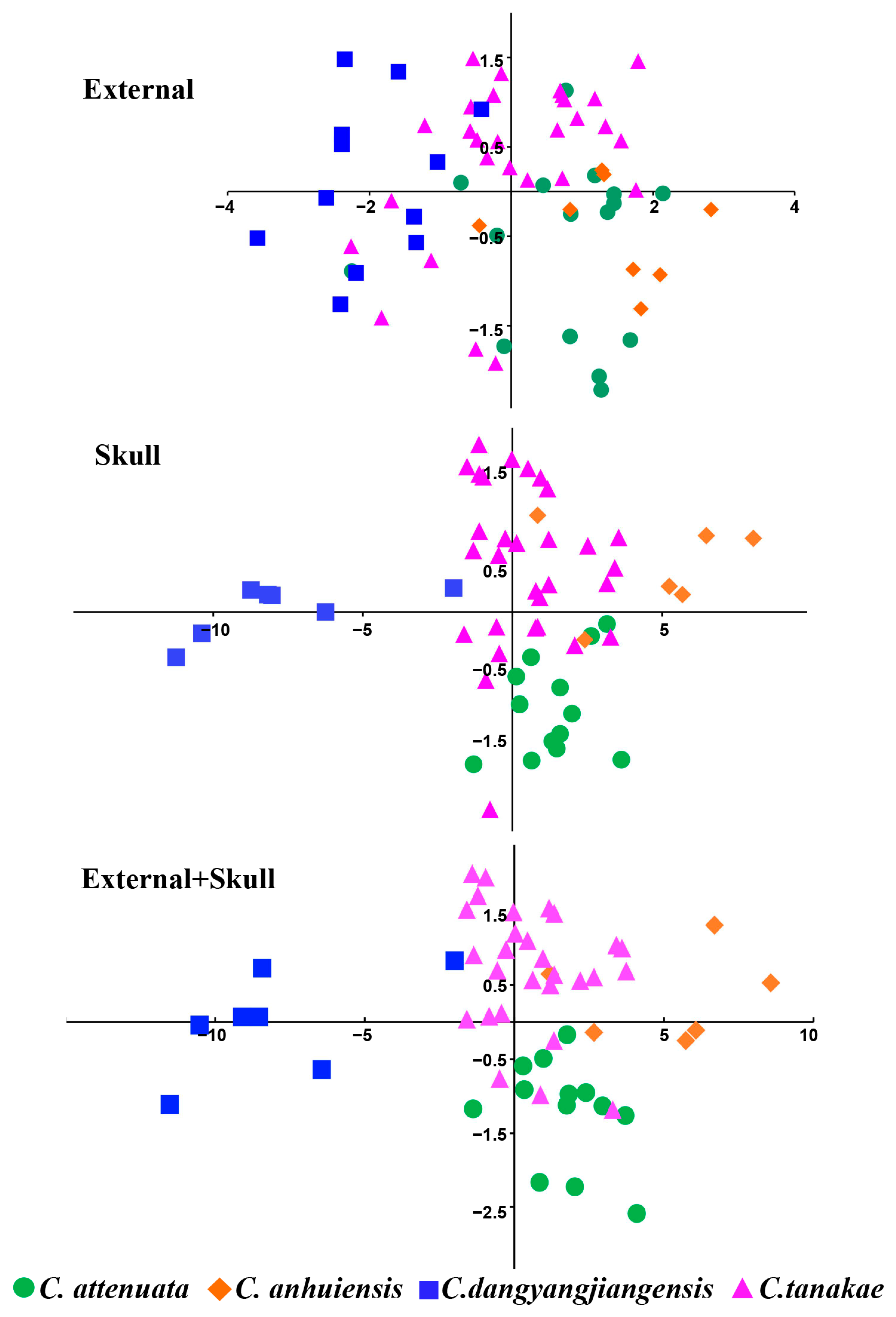
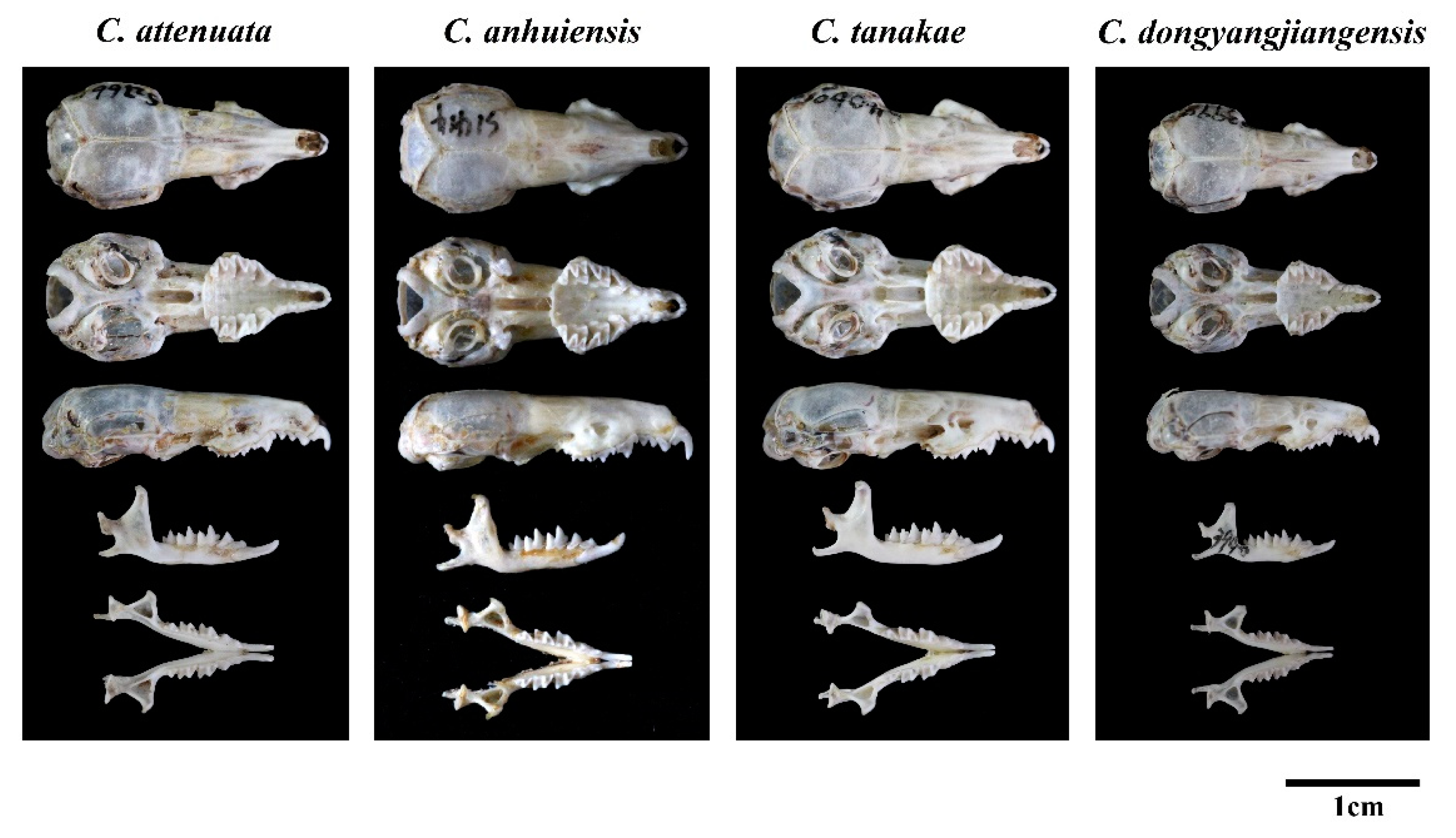
| C. tanakae | C. dongyangjiangensis | C. anhuiensis | C. attenuata | |
|---|---|---|---|---|
| C. tanakae | 0.0112 ± 0.0013 | |||
| C. dongyangjiangensis | 0.128 ± 0.013 | 0.0149 ± 0.0023 | ||
| C. anhuiensis | 0.129 ± 0.012 | 0.117 ± 0.012 | 0.0106 ± 0.002 | |
| C. attenuata | 0.136 ± 0.013 | 0.122 ± 0.012 | 0.041 ± 0.006 | 0.012 ± 0.0021 |
| Index | Item | C. tanakae | C. dongyangjiangensis | C. anhuiensis | C. attenuata |
|---|---|---|---|---|---|
| HB | Mean ± SD | 76.31 ± 6.60 | 63.82 ± 6.54 | 75.75 ± 3.95 | 74.88 ± 6.54 |
| Range | 64.00~95.00 | 55.00~78.50 | 69.00~82.50 | 61.00~85.00 | |
| N | 29 | 11 | 8 | 16 | |
| Tail | Mean ± SD | 52.29 ± 5.66 | 48.32 ± 4.11 | 58.75 ± 5.87 | 56.56 ± 4.80 |
| Range | 44.00~63.50 | 40.00~54.00 | 49.00~65.00 | 50.00~67.00 | |
| N | 28 | 11 | 8 | 16 | |
| Ear | Mean ± SD | 8.45 ± 1.29 | 7.70 ± 1.22 | 8.65 ± 0.68 | 7.96 ± 1.08 |
| Range | 5.76~11.06 | 5.58~9.44 | 7.93~9.85 | 6.05~9.68 | |
| N | 29 | 11 | 8 | 16 | |
| HF | Mean ± SD | 12.98 ± 0.66 | 11.39 ± 0.50 | 14.77 ± 0.71 | 14.19 ± 1.10 |
| Range | 12.01~14.44 | 10.35~11.96 | 13.84~15.66 | 11.74~16.53 | |
| N | 30 | 11 | 8 | 16 | |
| CIL | Mean ± SD | 20.20 ± 0.64 | 17.37 ± 0.88 | 21.34 ± 0.77 | 21.06 ± 0.56 |
| Range | 19.28~21.63 | 16.53~19.14 | 20.43~22.44 | 20.04~22.10 | |
| N | 30 | 7 | 7 | 14 | |
| MTR | Mean ± SD | 5.82 ± 0.15 | 4.89 ± 0.32 | 6.25 ± 0.22 | 5.88 ± 0.12 |
| Range | 5.59~6.13 | 4.54~5.58 | 5.91~6.51 | 5.67~6.07 | |
| N | 30 | 11 | 8 | 16 | |
| HCC | Mean ± SD | 4.96 ± 0.20 | 4.43 ± 0.30 | 5.15 ± 0.16 | 5.03 ± 0.14 |
| Range | 4.29~5.36 | 3.98~4.89 | 4.97~5.40 | 4.83~5.33 | |
| N | 30 | 8 | 8 | 15 | |
| RW | Mean ± SD | 2.48 ± 0.14 | 2.02 ± 0.15 | 2.62 ± 0.15 | 2.30 ± 0.16 |
| Range | 2.17~2.72 | 1.82~2.36 | 2.40~2.86 | 2.07~2.66 | |
| N | 30 | 11 | 8 | 16 | |
| MB | Mean ± SD | 6.64 ± 0.47 | 5.46 ± 0.33 | 7.02 ± 0.35 | 6.47 ± 0.28 |
| Range | 5.95~8.53 | 5.07~6.24 | 6.46~7.37 | 5.67~6.89 | |
| N | 30 | 11 | 8 | 16 | |
| IO | Mean ± SD | 4.43 ± 0.16 | 3.93 ± 0.20 | 4.90 ± 0.24 | 4.55 ± 0.15 |
| Range | 4.07~4.80 | 3.66~4.29 | 4.51~5.20 | 4.24~4.80 | |
| N | 30 | 10 | 8 | 15 | |
| GW | Mean ± SD | 9.13 ± 0.30 | 8.04 ± 0.35 | 9.80 ± 0.40 | 9.45 ± 0.29 |
| Range | 8.62~9.74 | 7.41~8.50 | 9.28~10.41 | 8.97~10.09 | |
| N | 30 | 9 | 7 | 15 | |
| PIL | Mean ± SD | 9.28 ± 0.30 | 7.71 ± 0.58 | 9.89 ± 0.50 | 9.56 ± 0.29 |
| Range | 8.69~9.91 | 6.78~8.99 | 9.24~10.68 | 9.01~10.18 | |
| N | 30 | 10 | 7 | 16 | |
| PAL | Mean ± SD | 7.83 ± 0.25 | 6.56 ± 0.48 | 8.36 ± 0.37 | 7.99 ± 0.27 |
| Range | 7.36~8.36 | 6.08~7.66 | 7.84~8.98 | 7.41~8.44 | |
| N | 30 | 9 | 8 | 16 | |
| PPL | Mean ± SD | 8.94 ± 0.40 | 7.72 ± 0.22 | 9.50 ± 0.37 | 9.45 ± 0.31 |
| Range | 8.16~9.70 | 7.42~8.14 | 8.90~10.05 | 8.88~10.02 | |
| N | 30 | 7 | 8 | 13 | |
| UTR | Mean ± SD | 8.93 ± 0.29 | 7.61 ± 0.46 | 9.61 ± 0.41 | 9.21 ± 0.24 |
| Range | 8.44~9.58 | 7.06~8.51 | 9.02~10.13 | 8.75~9.58 | |
| N | 30 | 11 | 7 | 16 | |
| P4-M3 | Mean ± SD | 5.12 ± 0.15 | 4.40 ± 0.28 | 5.57 ± 0.22 | 5.16 ± 0.12 |
| Range | 4.88~5.42 | 4.04~4.98 | 5.26~5.88 | 5.00~5.37 | |
| N | 30 | 11 | 8 | 16 | |
| PW1 | Mean ± SD | 6.17 ± 0.25 | 5.23 ± 0.33 | 6.59 ± 0.28 | 6.19 ± 0.20 |
| Range | 5.76~6.70 | 4.82~6.03 | 6.03~6.86 | 5.86~6.65 | |
| N | 30 | 10 | 8 | 15 | |
| PGL | Mean ± SD | 6.42 ± 0.23 | 5.57 ± 0.35 | 6.80 ± 0.34 | 6.49 ± 0.16 |
| Range | 6.03~7.04 | 5.21~6.39 | 6.32~7.22 | 6.23~6.87 | |
| N | 30 | 10 | 8 | 15 | |
| LDT2 | Mean ± SD | 8.18 ± 0.27 | 6.92 ± 0.43 | 8.86 ± 0.41 | 8.47 ± 0.19 |
| Range | 7.74~8.75 | 6.38~7.90 | 8.19~9.36 | 8.22~8.89 | |
| N | 30 | 11 | 8 | 16 | |
| LDT1 | Mean ± SD | 6.06 ± 0.22 | 5.24 ± 0.31 | 6.53 ± 0.44 | 6.20 ± 0.14 |
| Range | 5.59~6.47 | 4.93~5.92 | 5.51~6.87 | 6.02~6.51 | |
| N | 30 | 11 | 8 | 16 | |
| M1-M3 | Mean ± SD | 4.19 ± 0.14 | 3.65 ± 0.22 | 4.56 ± 0.18 | 4.24 ± 0.11 |
| Range | 3.91~4.44 | 3.37~4.11 | 4.23~4.74 | 4.10~4.43 | |
| N | 30 | 11 | 8 | 16 | |
| BCP | Mean ± SD | 1.07 ± 010 | 0.86 ± 0.09 | 1.16 ± 0.10 | 1.01 ± 0.10 |
| Range | 0.86~1.30 | 0.72~0.95 | 1.01~1.32 | 0.83~1.21 | |
| N | 30 | 11 | 8 | 16 | |
| ML | Mean ± SD | 12.68 ± 0.43 | 10.70 ± 0.64 | 13.78 ± 0.70 | 13.23 ± 0.41 |
| Range | 12.06~13.71 | 9.86~12.10 | 12.79~14.81 | 12.37~13.92 | |
| N | 30 | 10 | 8 | 16 | |
| COR | Mean ± SD | 4.84 ± 0.23 | 4.06 ± 0.26 | 5.29 ± 0.30 | 4.90 ± 0.20 |
| Range | 4.38~5.33 | 3.57~4.47 | 4.81~5.81 | 4.58~5.33 | |
| N | 30 | 11 | 8 | 16 |
Disclaimer/Publisher’s Note: The statements, opinions and data contained in all publications are solely those of the individual author(s) and contributor(s) and not of MDPI and/or the editor(s). MDPI and/or the editor(s) disclaim responsibility for any injury to people or property resulting from any ideas, methods, instructions or products referred to in the content. |
© 2023 by the authors. Licensee MDPI, Basel, Switzerland. This article is an open access article distributed under the terms and conditions of the Creative Commons Attribution (CC BY) license (https://creativecommons.org/licenses/by/4.0/).
Share and Cite
Li, H.; Li, Y.; Motokawa, M.; Wu, Y.; Harada, M.; Li, Y. The Effectiveness of Molecular, Karyotype and Morphological Methods in the Identification of Morphologically Conservative Sibling Species: An Integrative Taxonomic Case of the Crocidura attenuata Species Complex in Mainland China. Animals 2023, 13, 643. https://doi.org/10.3390/ani13040643
Li H, Li Y, Motokawa M, Wu Y, Harada M, Li Y. The Effectiveness of Molecular, Karyotype and Morphological Methods in the Identification of Morphologically Conservative Sibling Species: An Integrative Taxonomic Case of the Crocidura attenuata Species Complex in Mainland China. Animals. 2023; 13(4):643. https://doi.org/10.3390/ani13040643
Chicago/Turabian StyleLi, Haotian, Yaoyao Li, Masaharu Motokawa, Yi Wu, Masashi Harada, and Yuchun Li. 2023. "The Effectiveness of Molecular, Karyotype and Morphological Methods in the Identification of Morphologically Conservative Sibling Species: An Integrative Taxonomic Case of the Crocidura attenuata Species Complex in Mainland China" Animals 13, no. 4: 643. https://doi.org/10.3390/ani13040643
APA StyleLi, H., Li, Y., Motokawa, M., Wu, Y., Harada, M., & Li, Y. (2023). The Effectiveness of Molecular, Karyotype and Morphological Methods in the Identification of Morphologically Conservative Sibling Species: An Integrative Taxonomic Case of the Crocidura attenuata Species Complex in Mainland China. Animals, 13(4), 643. https://doi.org/10.3390/ani13040643






